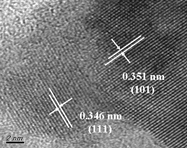Crossref Citations
This article has been cited by the following publications. This list is generated based on data provided by
Crossref.
Lü, Xiaomeng
Shen, Jiayu
Wu, Ziwei
Wang, Jiaxi
and
Xie, Jimin
2014.
Deposition of Ag nanoparticles on g-C3N4nanosheet byN,N-dimethylformamide: Soft synthesis and enhanced photocatalytic activity.
Journal of Materials Research,
Vol. 29,
Issue. 18,
p.
2170.
Zheng, Jianyun
Bao, Shanhu
Guo, Yu
and
Jin, Ping
2014.
TiO2 films prepared by DC reactive magnetron sputtering at room temperature: Phase control and photocatalytic properties.
Surface and Coatings Technology,
Vol. 240,
Issue. ,
p.
293.
Shen, Jianfeng
Li, Xianfu
Huang, Weishi
Li, Na
and
Ye, Mingxin
2014.
One-pot polyelectrolyte assisted hydrothermal synthesis of NiFe2O4-reduced graphene oxide nanocomposites with improved electrochemical and photocatalytic properties.
Journal of Materials Research,
Vol. 29,
Issue. 18,
p.
2211.
Li, Zhen
Cong, Shan
and
Xu, Yiming
2014.
Brookite vs Anatase TiO2 in the Photocatalytic Activity for Organic Degradation in Water.
ACS Catalysis,
Vol. 4,
Issue. 9,
p.
3273.
Kumar, S. Girish
and
Rao, K. S. R. Koteswara
2014.
Polymorphic phase transition among the titania crystal structures using a solution-based approach: from precursor chemistry to nucleation process.
Nanoscale,
Vol. 6,
Issue. 20,
p.
11574.
Lü, Xiaomeng
Shen, Jiayu
Wang, Jiaxi
Cui, Zhengshan
and
Xie, Jimin
2015.
Highly efficient visible-light photocatalysts: reduced graphene oxide and C3N4nanosheets loaded with Ag nanoparticles.
RSC Advances,
Vol. 5,
Issue. 21,
p.
15993.
Luo, Bangde
Li, Zhen
and
Xu, Yiming
2015.
The positive effect of anatase and rutile on the brookite-photocatalyzed degradation of phenol.
RSC Advances,
Vol. 5,
Issue. 128,
p.
105999.
Lü, Xiaomeng
Shen, Jiayu
Fan, Dongliang
Wang, Jiaxi
Cui, Zhengshan
and
Xie, Jimin
2015.
Solvothermal engineering of bismuth molybdate with C3N4 nanosheets, and enhanced photocatalytic activity.
Research on Chemical Intermediates,
Vol. 41,
Issue. 12,
p.
9629.
Yasin, Amrita
Guo, Fuqiang
Sussman, Micah J.
Gauvin, Raynald
and
Demopoulos, George P.
2016.
Steady‐State, Scalable Production of Mesoporous Rutile and Brookite Particles and Their Use in Energy Conversion and Storage Cells.
ChemNanoMat,
Vol. 2,
Issue. 10,
p.
980.
Shi, Mingjin
Wei, Wei
Jiang, Zhifeng
Han, Hekun
Gao, Jinrong
and
Xie, Jimin
2016.
Biomass-derived multifunctional TiO2/carbonaceous aerogel composite as a highly efficient photocatalyst.
RSC Advances,
Vol. 6,
Issue. 30,
p.
25255.
El-Sheikh, Said M.
Khedr, Tamer M.
Zhang, Geshan
Vogiazi, Vasileia
Ismail, Adel A.
O’Shea, Kevin
and
Dionysiou, Dionysios D.
2017.
Tailored synthesis of anatase–brookite heterojunction photocatalysts for degradation of cylindrospermopsin under UV–Vis light.
Chemical Engineering Journal,
Vol. 310,
Issue. ,
p.
428.
Khedr, Tamer M.
El-Sheikh, Said M.
Hakki, Amer
Ismail, Adel A.
Badawy, Waheed A.
and
Bahnemann, Detlef W.
2017.
Highly active non-metals doped mixed-phase TiO 2 for photocatalytic oxidation of ibuprofen under visible light.
Journal of Photochemistry and Photobiology A: Chemistry,
Vol. 346,
Issue. ,
p.
530.
Khedr, Tamer M.
El-Sheikh, Said M.
Abdeldayem, Hany M.
Ismail, Adel A.
Kowalska, Ewa
and
Bahnemann, Detlef W.
2019.
A Comparative Study of Microcystin-LR Degradation by UV-A, Solar and Visible Light Irradiation Using Bare and C/N/S-Modified Titania.
Catalysts,
Vol. 9,
Issue. 11,
p.
877.
Khedr, Tamer M.
El-Sheikh, Said M.
Kowalska, Ewa
and
Abdeldayem, Hany M.
2021.
The synergistic effect of anatase and brookite for photocatalytic generation of hydrogen and diclofenac degradation.
Journal of Environmental Chemical Engineering,
Vol. 9,
Issue. 6,
p.
106566.
Kompa, Akshayakumar
U, Chaitra
Kekuda, Dhananjaya
and
Rao K, Mohan
2021.
Investigation on structural, optical and electrical properties of Nd doped titania films and application of optical model.
Materials Science in Semiconductor Processing,
Vol. 121,
Issue. ,
p.
105293.





